
Nero Claudius Caesar Augustus Germanicus and his reign have featured in music, literature, the arts, and in business.

Nero Claudius Caesar Augustus Germanicus and his reign have featured in music, literature, the arts, and in business.

See also: Nero (Character) imdb.com page

Tiberius Claudius Caesar Augustus Germanicus was a Roman emperor, ruling from AD 41 to 54. A member of the Julio-Claudian dynasty, Claudius was born to Drusus and Antonia Minor at Lugdunum in Roman Gaul, where his father was stationed as a military legate. He was the first Roman emperor to be born outside Italy.
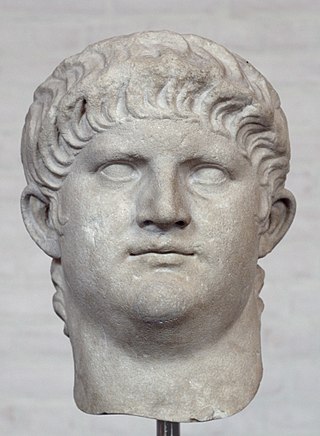
Nero Claudius Caesar Augustus Germanicus was a Roman emperor and the final emperor of the Julio-Claudian dynasty, reigning from AD 54 until his death in AD 68.

Quo vadis? is a Latin phrase meaning "Where are you going?" It is commonly translated, quoting the KJV translation of John 13:36, as "Whither goest thou?"
Ofonius Tigellinus was a prefect of the Roman imperial bodyguard, known as the Praetorian Guard, from 62 until 68, during the reign of emperor Nero. Tigellinus gained imperial favour through his acquaintance with Nero's mother Agrippina the Younger, and was appointed prefect upon the death of his predecessor Sextus Afranius Burrus, a position Tigellinus held first with Faenius Rufus and then Nymphidius Sabinus.

Quo Vadis is a 1951 American religious epic film set in ancient Rome during the final years of Emperor Nero's reign, based on the 1896 novel of the same title by Polish Nobel Laureate author Henryk Sienkiewicz. Produced by Metro-Goldwyn-Mayer and filmed in Technicolor, it was directed by Mervyn LeRoy from a screenplay by S. N. Behrman, Sonya Levien, and John Lee Mahin. It is the fourth screen adaptation of Sienkiewicz's novel. The film stars Robert Taylor, Deborah Kerr, Leo Genn, and Peter Ustinov, and features Patricia Laffan, Finlay Currie, Abraham Sofaer, Marina Berti, Buddy Baer, and Felix Aylmer. Future Italian stars Sophia Loren and Bud Spencer appeared as uncredited extras. The score is by Miklós Rózsa and the cinematography by Robert Surtees and William V. Skall. The film was released by Metro-Goldwyn-Mayer on November 2, 1951.
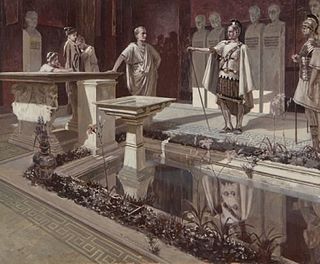
Aulus Plautius was a Roman politician and general of the mid-1st century. He began the Roman conquest of Britain in 43, and became the first governor of the new province, serving from 43 to 46.
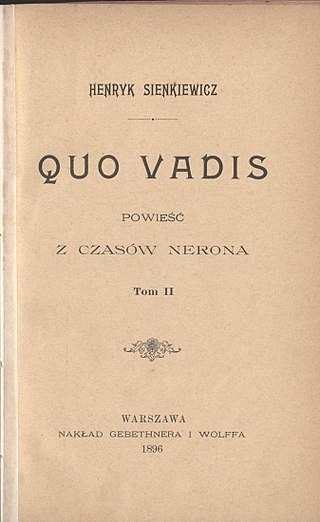
Quo Vadis: A Narrative of the Time of Nero is a historical novel written by Henryk Sienkiewicz in Polish.

Poppaea Sabina, also known as Ollia, was a Roman empress as the second wife of the emperor Nero. She had also been wife to the future emperor Otho. The historians of antiquity describe her as a beautiful woman who used intrigues to become empress.
Nero was the Roman emperor from 54 to 68 AD.
Claudia Acte was a freedwoman of ancient Rome who became a mistress of the emperor Nero. She came from Asia Minor and might have become a slave of the Emperor Claudius, following his expansion of the Roman Empire into Lycia and Pamphylia; or she might have been purchased later, by Octavia, Claudius' daughter.

Gnaeus Domitius Ahenobarbus was a member of the imperial Julio-Claudian dynasty of Ancient Rome. Domitius was the son of Antonia Major. He married Agrippina the Younger and became the father of the emperor Nero.
Pomponia Graecina was a noble Roman woman of the 1st century who was related to the Julio-Claudian dynasty. She was the wife of Aulus Plautius, the general who led the Roman conquest of Britain in 43 AD, and was renowned as one of the few people who dared to publicly mourn the death of a kinswoman killed by the Imperial family. It has been speculated that she was an early Christian. She is identified by some as Lucina or Lucy, a saint honoured by the Roman Catholic Church.
Sporus was a young slave boy whom the Roman Emperor Nero had castrated and married as his Empress during his tour of Greece in 66–67 CE, allegedly in order for him to play the role of his wife, Poppaea Sabina, who had died the previous year.

Domine, quo vadis? is a 1602 painting by the Italian Baroque painter Annibale Carracci (1560–1609), depicting a scene from the apocryphal Acts of Peter. It is housed in the National Gallery, where it is given the title Christ appearing to Saint Peter on the Appian Way. The subject is a rare representation in art of the theme Quo vadis. Annibale Carracci was the founder of the Italian Baroque painting school, called Bolognese School. This painting is one of his best known works. Peter is depicted fleeing Rome to avoid crucifixion and has a vision of meeting Christ bearing his Cross. Peter asks Jesus "Quo vadis?" to which he replies, "Romam vado iterum crucifigi". Peter returns to Rome after this vision.
Nero Burning ROM, commonly called Nero, is an optical disc authoring program from Nero AG. The software is part of the Nero Multimedia Suite but is also available as a stand-alone product. It is used for burning and copying optical media such as CDs, DVDs, and Blu-ray disks. The program also supports the label printing technologies LightScribe and LabelFlash, and can be used to convert audio files into other audio formats.
Phaon was an imperial freedman and confidant of the Roman emperor Nero. He, with Epaphroditus, Neophytus and Sporus, took Nero to his own villa in the suburban area of Rome where the emperor would commit suicide subsequently.
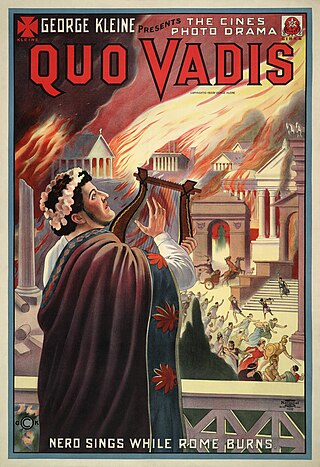
Quo Vadis is an Italian film directed by Enrico Guazzoni for Cines in 1913, based on the 1896 novel of the same name written by Henryk Sienkiewicz. It was one of the first blockbusters in the history of cinema, with 5,000 extras, lavish sets, and a lengthy running time of two hours, setting the standard for "superspectacles" for decades to come.
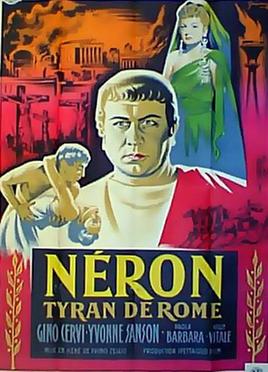
Nero and the Burning of Rome is a 1953 Italian epic historical drama film directed by Primo Zeglio and loosely based on real life events of Roman emperor Nero. It was based on the novel Nerone e Messalina (c.1949) by Harry Bluhmen.

The Trials of Apollo is a pentalogy of fantasy adventure and mythological fiction novels written by American author Rick Riordan that collectively form a sequel to the Heroes of Olympus series. It is set in the same world as Riordan's Percy Jackson and Heroes of Olympus series and references characters and happenings from earlier stories. A supplementary book, Camp Jupiter Classified, has also been released in addition to the main series.
NOTE link appears not to be active